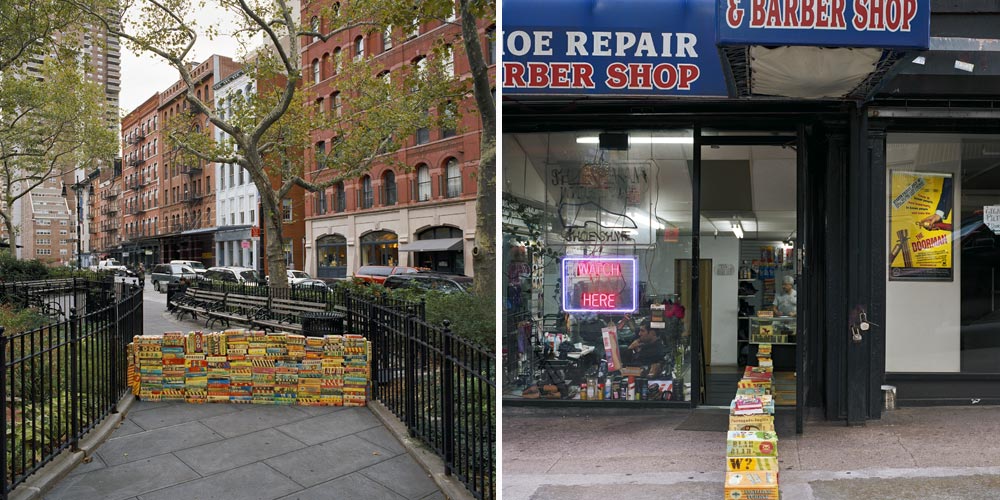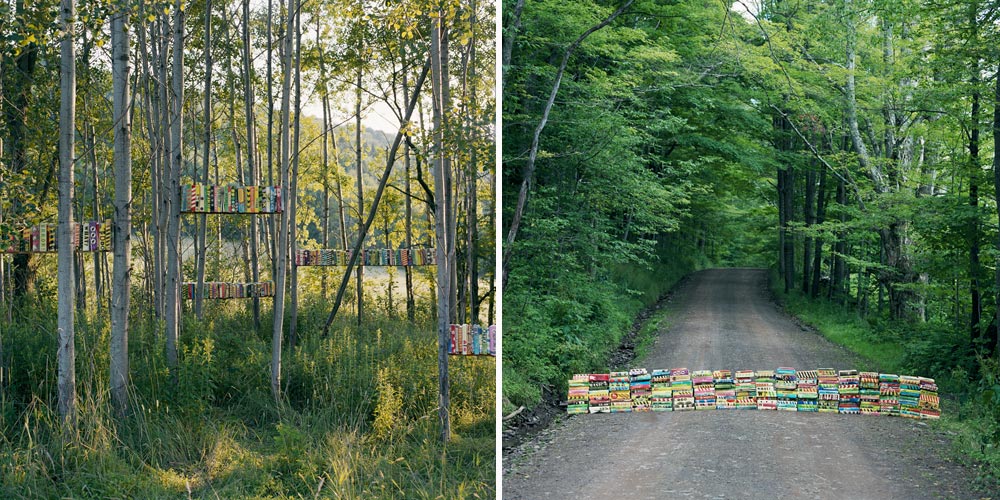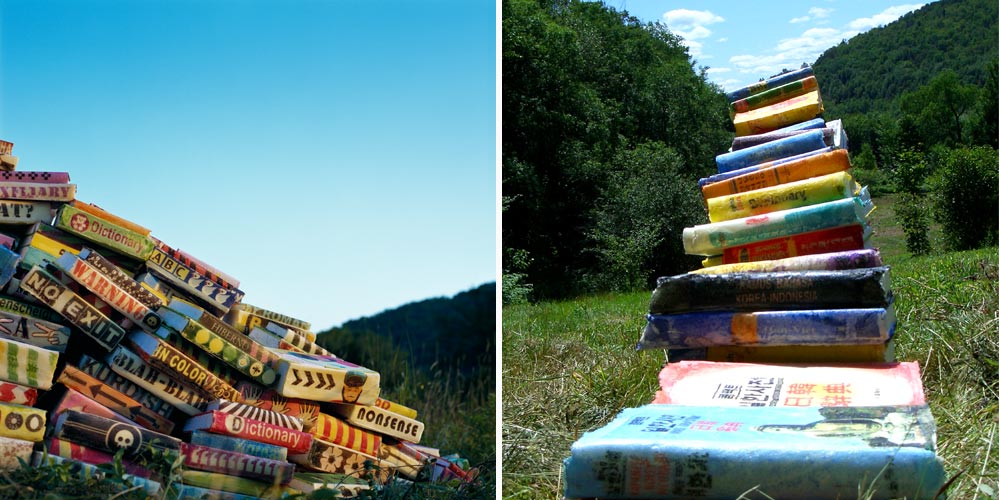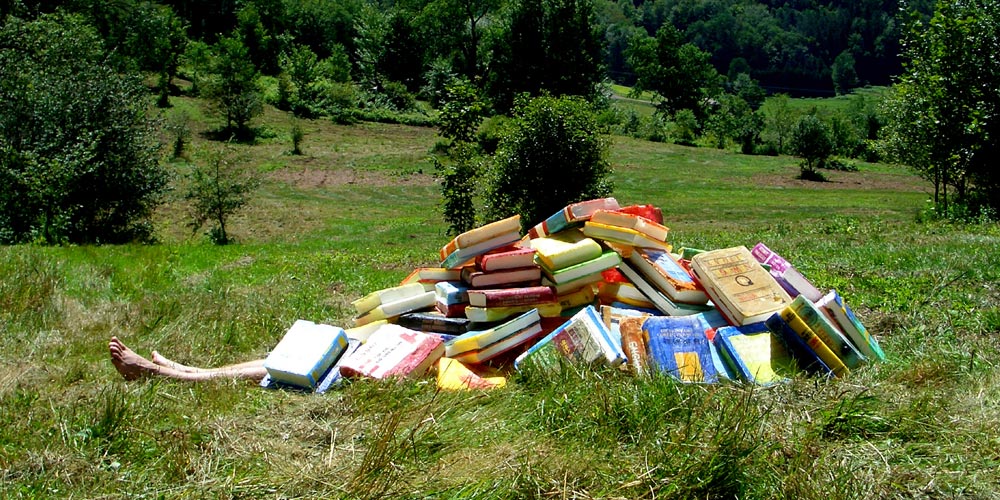LANGUAGE BARRIER, LOWER MANHATTAN
Site-specific installation Language Barrier, Lower Manhattan (September 29-October 3, 2008) engages issues of immigration, assimilation and alienation among the various diasporic communities of the neighborhood. We selected five different sites in lower Manhattan, each selected for its contemporary and historical significance and intervene in various corridors with piles of cast-foam dictionaries.
By obscuring sightlines, blocking windows and physically interrupting daily routines, the project draw attention to the social and cultural differences that characterize life in New York City throughout its history. For the lower Manhattan installation, every site represents an aspect of the community, geography and past of this vibrant area, from its importance as a farm, to its own Industrial Revolution in the nineteenth century, to its gentrification into the coveted real estate it is today. Within this sea of change, different immigrant populations struggled and continue to grapple with questions of communication, adaptation and social reorganization.
The installation of colorful cast-foam dictionaries, each uniquely designed, printed and painted, in the forms of different barriers at each successive location underlines the fragility of communication, the construction of language and our need for translation. Practical and theoretical considerations meet formally during this ephemeral urban intervention, making visible our daily negotiation of barriers both physical and social.
Language Barrier, Duane Park, Lower Manhattan Named after James Duane (1733-1797) New York's first mayor after the Revolutionary War, Duane Park is the last remaining corner of a 62-acre farm belonging to a Dutch settler named Anneke Jans Bogardus whose husband received the land from the governor of New Amsterdam in 1636. As the first public space acquired by the City specifically for use as a public park, this 0.115 acre piece was bought from the Trinity Church for five dollars in 1797.
Language Barrier, Patel News Stand, Lower Manhattan The newsstand awakens with the city, an integral stop in the morning for most commuters. As the first place one might go after leaving home, the stand exists between one destination and the next, a pivotal, but usually very brief interaction. Physically the structure mirrors this status, neither completely permanent nor completely temporary, having as much inside as outside. Kiosks reflect the demographics of their population-the languages, interests and lifestyle choices packed into their dense shelves.
Language Barrier, Jin Market, Lower Manhattan Delis are quintessentially New York. Historically immigrant owned, they reflect the diversity of the communities they serve and the ones from which they came. And in true Big Apple tradition, they are often open 24 hours a day. Fresh flowers adorn Jin Market's front wall, flown in from all around the world, Ecuadorian roses, Californian gladioli and Dutch tulips. But behind this colorful facade lies the complexity of the global marketplace that provided them, a vast network of relations, commercial, physical, temporal, political and social, that underpin every daily transaction and purchase.
Language Barrier, Civitella Ranieri Foundation, Lower Manhattan Located in two sites, one blocks from the Hudson River in a nineteenth century building formerly used as a warehouse, and the other, a fifteenth century castle in the Umbria region of Italy, the Foundation bridges centuries, continents and also communities. By blocking the windows between the City street and the office, the installation of dictionaries both insists upon the differences between these unique environments and suggests the possibility of cultural exchange and communication.
Language Barrier, Express Shoe Repair and Barber Shop, Lower Manhattan 59 Franklin Street used to be a cloth warehouse. Now, Express Shoe Repair and Barber Shop, owned by Yurev Israelov, a Russian Jew from the former Soviet Union, is one of the last commercial tenants on the block. Yurev runs traditional businesses that are fast disappearing, let alone this unusual combination under one roof. A row of shoeshine chairs faces the backs of a row of parallel barber chairs, both lines redolent of another time, a different set of voices. Exposing and cutting through differences of class and race, these traditional professions are either quickly transforming or dying out.
LANGUAGE BARRIER, ANDES, NY
The term barrier is a statement of perceived circumstance. Whether keeping something out, or something else in, the word signifies a thing at times physical and metaphorical, demarcating a space known from one unknown or one once known, an emphatic reminder of the difference between here and there. Or is it? A confrontation with a barrier may provide also a moment of arrest, an exposure to a rip in the fabric of quotidian life that allows us to examine our behaviors, movements and communications. Barriers can be permeable.
"...Alina and Jeff Bliumis have installed the barricades around their studio near Andes, NY, a small town in the Catskills. Here, language is tied directly to the land in a way that suggests the connection between a territory and the tongue spoken there - a joint notion of a geographic location and the cultural identity of those who inhabit it: in short, nationhood... The walls built by Alina and Jeff form a nearly continuous line as they wind through the landscape. Even when they appear to break, as in the image of the wall straddling the road, they are actually continued a short distance away as they join an old stone farm wall or extend up a path cut through a grassy field. They often join with existing physical features or transform into new versions of them, as seen in the photograph of the books tucked under the tree limb that seem to join the distant hill to form a shallow valley, or in the case where books are heaped at left and form a cleft together with the mountain descending to meet it at right. Alina and Jeff thus define their own territory, carving out their parcel of reality, and linking themselves to land they have chosen, rather than a land into which they were merely born by chance. They may speak English, Russian, or a language of their own devise in this newly demarcated land, where the language barriers could be seen as a protective cordon rather than an unbreachable wall..." Excerpt from Itinerant Borders by Elizabeth M. Grady, Dam Lines catalog, 2008
Language Barrier, Lower Manhattan and Andes, NY, 2006-2008, C-print, 30 x 30 inches each, Edition of 6
Language Barrier, Lower Manhattan, 2008, Site-specific installation, Cast foam, acrylic, ink, Dimensions variable
Language Barrier, Andes, NY, 2006-2008, Site-specific installation, Cast foam, acrylic, ink, Dimensions variable







